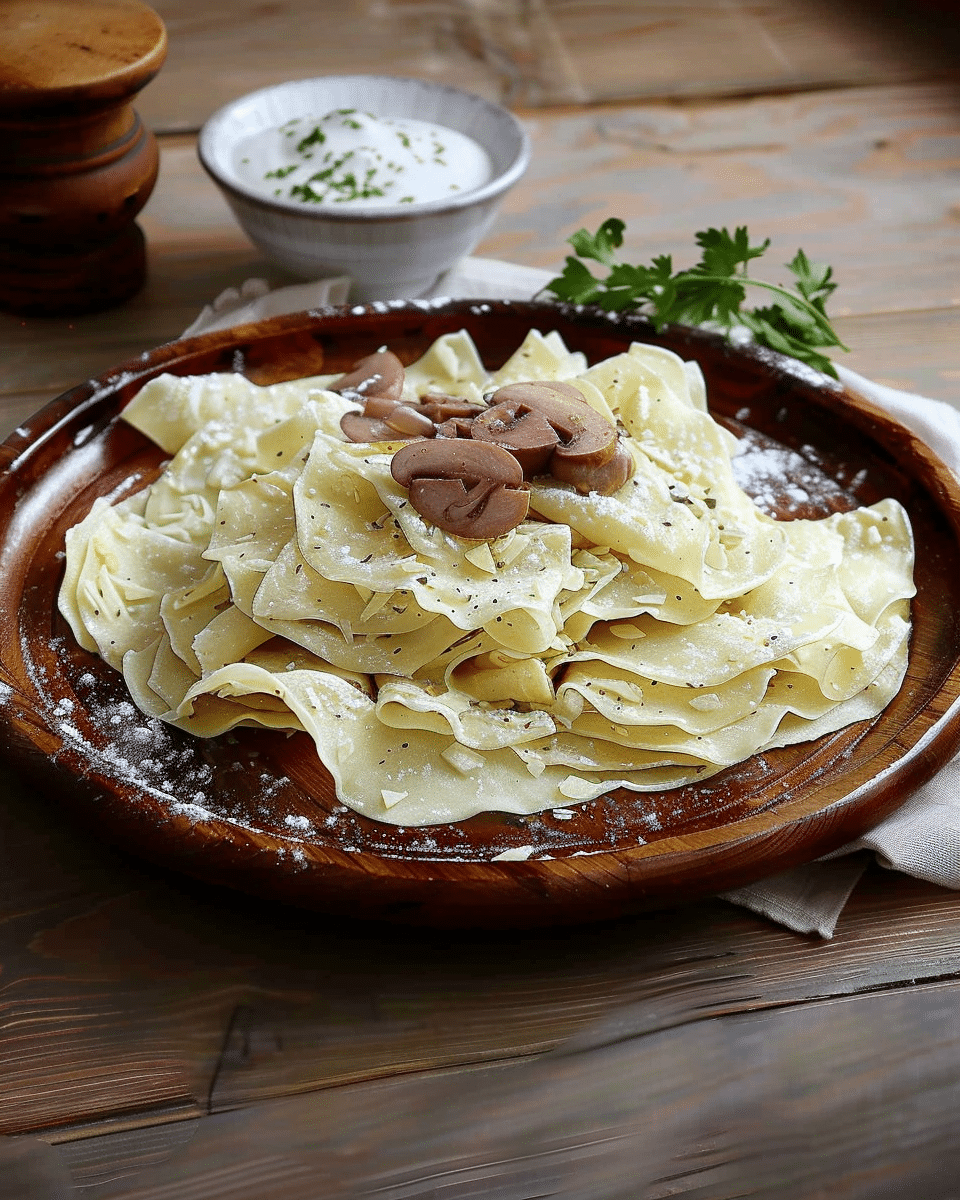Why You’ll Love This Recipe
Beshbarmak is a flavorful and filling dish that combines tender meat, delicate noodles, and a savory onion broth in a way that is both satisfying and comforting. The dish’s simplicity makes it perfect for family-style meals, and its robust flavors will leave everyone coming back for more. The slow-cooked meat is juicy and tender, while the noodles soak up all the delicious broth, making every bite a treat. Whether you’re seeking a hearty meal to share or exploring new global cuisines, Beshbarmak is sure to become a favorite.
Ingredients
For the meat:
-
2 lbs (900g) beef, lamb, or horse meat (bone-in cuts like shank or shoulder work best)
-
1 onion, quartered
-
2-3 bay leaves
-
1 tablespoon whole black peppercorns
-
4 cloves garlic, smashed
-
Salt to taste
For the noodles:
-
2 cups all-purpose flour
-
1 egg
-
1/4 cup water (or more, as needed)
-
1/2 teaspoon salt
For the onion broth:
-
1-2 large onions, thinly sliced
-
1 tablespoon vegetable oil
-
Salt and pepper to taste
For garnish:
-
Fresh parsley or cilantro (optional)
(Tip: You’ll find the full list of ingredients and measurements in the recipe card below.)
Directions
1. Cook the meat:
In a large pot, place the meat, onion, garlic, bay leaves, peppercorns, and a pinch of salt. Cover with water and bring to a boil. Once it begins to boil, reduce the heat to low and simmer for 2-3 hours, or until the meat is tender and falling off the bone. Occasionally skim off any foam or impurities that rise to the surface.
Once the meat is cooked, remove it from the pot and let it rest for a few minutes before shredding it into bite-sized pieces. Reserve the broth for later use.
2. Make the noodles:
In a large bowl, combine the flour and salt. Add the egg and gradually add water until the dough comes together. Knead the dough for 5-10 minutes until it’s smooth and elastic. Cover it with a damp cloth and let it rest for about 30 minutes.
Once rested, roll out the dough into a thin sheet and cut it into wide strips (about 1-2 inches wide). You can also use a pasta cutter to make even, uniform noodles. Set the noodles aside.
3. Prepare the onion broth:
While the meat is cooking, heat vegetable oil in a large pan over medium heat. Add the thinly sliced onions and cook for about 10 minutes, until they’re softened and slightly caramelized. Season with salt and pepper to taste. Once done, set the onions aside.
4. Cook the noodles:
Bring the reserved broth to a boil again. Drop the noodles into the boiling broth in batches, stirring gently to prevent sticking. Cook the noodles for 3-4 minutes or until they float to the top. Once cooked, use a slotted spoon to transfer them to a serving dish.
5. Assemble the Beshbarmak:
To serve, place a layer of cooked noodles on a large platter. Top with the shredded meat and pour some of the flavorful broth over it. Scatter the caramelized onions on top and garnish with fresh parsley or cilantro for added freshness.
6. Serve:
Serve Beshbarmak hot, with additional broth on the side for extra flavor. Traditionally, this dish is eaten by hand, but you can also serve it with forks and spoons.
Servings and Timing
-
Servings: 6-8
-
Total time: 3.5-4 hours (including meat cooking time)
Variations
-
Vegetarian Beshbarmak: You can make a vegetarian version of Beshbarmak by replacing the meat with mushrooms or a combination of hearty vegetables like carrots, potatoes, and bell peppers. Simmer the vegetables in broth and prepare the dish as usual.
-
Spicy Beshbarmak: Add a pinch of chili powder or red pepper flakes to the broth for a spicy version. You can also serve it with chili sauce or hot pepper paste on the side for those who prefer extra heat.
-
Beshbarmak with Rice: While traditionally made with noodles, some versions of Beshbarmak are served with rice instead of noodles. The rice will absorb the broth and provide a different texture to the dish.
Storage/Reheating
-
Storage: Leftover Beshbarmak can be stored in an airtight container in the refrigerator for up to 2-3 days. Keep the meat and noodles separate if possible to maintain their texture.
-
Reheating: To reheat, gently warm the meat and noodles in a pot with some of the reserved broth. You can also microwave individual servings, though the texture may be slightly different.
FAQs
1. Can I use a different meat for Beshbarmak?
Yes, you can use any tender meat for Beshbarmak, but beef, lamb, or horse meat are the most common choices. You can also use chicken for a lighter version, although the flavor will be different.
2. Can I make the noodles ahead of time?
Yes, you can make the noodles ahead of time, dry them, and store them in an airtight container. When ready to use, simply cook them in the broth as you would with freshly made noodles.
3. Is Beshbarmak gluten-free?
No, traditional Beshbarmak is not gluten-free because it uses wheat flour in the noodles. However, you can make gluten-free noodles by using gluten-free flour blends or rice noodles as a substitute.
4. Can I make Beshbarmak in a slow cooker?
Yes, you can use a slow cooker to make Beshbarmak. Add the meat, onion, garlic, and spices to the slow cooker, cover with water, and cook on low for 6-8 hours or until the meat is tender. Cook the noodles separately and assemble the dish as usual.
5. How do I make Beshbarmak with a more flavorful broth?
For a richer broth, you can add beef or lamb bones along with the meat and simmer them for a few hours to extract more flavor. You can also add herbs like bay leaves, rosemary, or thyme for additional depth.
6. Can I freeze Beshbarmak?
Yes, you can freeze the cooked meat and broth separately from the noodles. To reheat, thaw and gently warm the meat and broth, and cook fresh noodles if necessary.
7. What is the traditional way to eat Beshbarmak?
Traditionally, Beshbarmak is eaten by hand in Kazakhstan, as the name “Beshbarmak” means “five fingers.” However, you can also use utensils if you prefer.
Conclusion
Beshbarmak is a delicious, hearty dish that brings together the rich flavors of tender meat, savory broth, and delicate noodles. It’s a wonderful representation of Kazakh cuisine and offers a unique and satisfying dining experience. Whether you’re making it for a special occasion or just want to enjoy a comforting homemade meal, Beshbarmak is sure to impress with its deep, satisfying flavors.
Beshbarmak
5 Stars 4 Stars 3 Stars 2 Stars 1 Star
No reviews
Beshbarmak is a traditional dish from Kazakhstan, consisting of tender meat (usually lamb, beef, or horse), served with flat noodles and a savory onion broth. It’s often eaten by hand and is a hearty, comforting meal.
- Author: Laura
- Prep Time: 30 minutes
- Cook Time: 3 hours
- Total Time: 3.5-4 hours (including meat cooking time)
- Yield: 6-8 servings
- Category: Main Dish
- Method: Simmered
- Cuisine: Kazakh
- Diet: Gluten Free
Ingredients
- 2 lbs (900g) beef, lamb, or horse meat (bone-in cuts like shank or shoulder work best)
1 onion, quartered
2–3 bay leaves
1 tablespoon whole black peppercorns
4 cloves garlic, smashed
Salt to taste
2 cups all-purpose flour
1 egg
1/4 cup water (or more, as needed)
1/2 teaspoon salt
1–2 large onions, thinly sliced
1 tablespoon vegetable oil
Salt and pepper to taste
Fresh parsley or cilantro (optional, for garnish)
Instructions
Cook the meat: In a large pot, place the meat, onion, garlic, bay leaves, peppercorns, and a pinch of salt. Cover with water and bring to a boil. Once it begins to boil, reduce the heat to low and simmer for 2-3 hours, or until the meat is tender and falling off the bone. Occasionally skim off any foam or impurities that rise to the surface. Once the meat is cooked, remove it from the pot and let it rest for a few minutes before shredding it into bite-sized pieces. Reserve the broth for later use.
- Make the noodles: In a large bowl, combine the flour and salt. Add the egg and gradually add water until the dough comes together. Knead the dough for 5-10 minutes until it’s smooth and elastic. Cover it with a damp cloth and let it rest for about 30 minutes. Once rested, roll out the dough into a thin sheet and cut it into wide strips (about 1-2 inches wide). Set the noodles aside.
- Prepare the onion broth: While the meat is cooking, heat vegetable oil in a large pan over medium heat. Add the thinly sliced onions and cook for about 10 minutes, until they’re softened and slightly caramelized. Season with salt and pepper to taste. Once done, set the onions aside.
- Cook the noodles: Bring the reserved broth to a boil again. Drop the noodles into the boiling broth in batches, stirring gently to prevent sticking. Cook the noodles for 3-4 minutes or until they float to the top. Once cooked, use a slotted spoon to transfer them to a serving dish.
- Assemble the Beshbarmak: To serve, place a layer of cooked noodles on a large platter. Top with the shredded meat and pour some of the flavorful broth over it. Scatter the caramelized onions on top and garnish with fresh parsley or cilantro for added freshness.
- Serve: Serve Beshbarmak hot, with additional broth on the side for extra flavor. Traditionally, this dish is eaten by hand, but you can also serve it with forks and spoons.
Notes
- Vegetarian Beshbarmak: You can make a vegetarian version by replacing the meat with mushrooms or a combination of hearty vegetables like carrots, potatoes, and bell peppers.
- Spicy Beshbarmak: Add a pinch of chili powder or red pepper flakes to the broth for a spicy version.
- Beshbarmak with Rice: While traditionally made with noodles, you can substitute rice instead of noodles for a different texture.
- Storage: Leftover Beshbarmak can be stored in an airtight container in the refrigerator for up to 2-3 days. Keep the meat and noodles separate if possible to maintain their texture.
- Reheating: Gently warm the meat and noodles in a pot with some of the reserved broth. You can also microwave individual servings.
Nutrition
- Serving Size: 1 serving
- Calories: 450
- Sugar: 4g
- Sodium: 800mg
- Fat: 15g
- Saturated Fat: 4g
- Unsaturated Fat: 10g
- Trans Fat: 0g
- Carbohydrates: 45g
- Fiber: 3g
- Protein: 32g
- Cholesterol: 60mg



